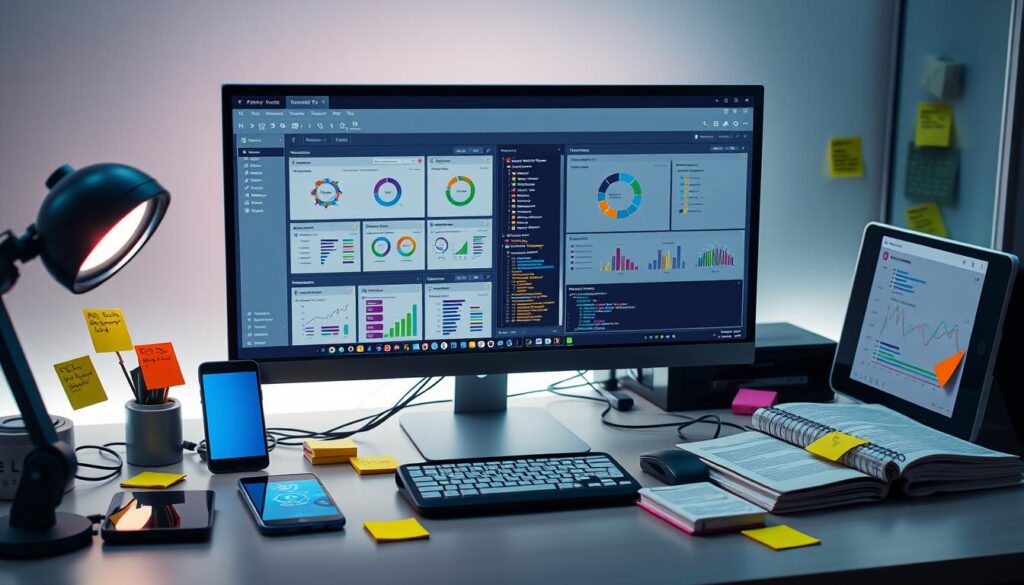Essential Android Development Tools for 2024
As an experienced Android developer, I’ve seen a lot of changes. From Java to Kotlin1, our tools have gotten better. Now, making apps is easier than ever. It’s important to know the best tools for 2024.
In this guide, we’ll look at the top Android development tools. They will help you make apps that users love. This article is for both new and experienced developers. It will help you keep up with the latest trends and make great apps.
Key Takeaways
- Discover the latest Integrated Development Environments (IDEs) that will streamline your coding workflow
- Understand the importance of version control systems and collaborative platforms like GitHub
- Explore build automation tools that simplify the complexities of dependency management and project organization
- Learn about the cutting-edge user interface design tools that enable rapid prototyping and seamless user experiences
- Uncover the essential testing and debugging tools that ensure the quality and performance of your Android applications
Introduction to Android Development Tools
Starting our Android development journey means picking the right tools is key. These tools boost our productivity and make our work better2. The Android SDK offers a range of tools, like Android Studio, for coding, testing, and fixing bugs2. We also have specialized SDKs for different needs, like the Android NDK and Firebase SDK2.
Importance of Choosing the Right Tools
Choosing the right tools for our projects is crucial. The right tools can greatly improve our work quality and efficiency3. Android is the top mobile platform, with a huge market share by 20213. Keeping up with the latest tools and trends is vital to stay ahead and create top-notch apps.
Overview of 2024 Trends
In 2024, we’ll see big changes in Android development3. Kotlin will become even more popular, alongside Java, for Android coding3. Cross-platform development will also grow, making apps work on many devices3. AI tools will change how we code, making it faster and more efficient3. Android Studio will still be the main IDE, with Jetpack Compose becoming more popular for UI design.
By keeping up with trends and using the right tools, we can improve our Android skills. This will help us make apps that meet today’s user needs3. With a strong SDK, diverse tools, and a growing community, we can create amazing user experiences in the future.
Integrated Development Environments (IDEs)
The world of Android development is always changing. Choosing the right Integrated Development Environment (IDE) is more important than ever4. Android Studio, the official IDE, is a top pick for many developers4. It comes with features like a Gradle-based build system, an emulator, and live edit capabilities4.
Android Studio: The Go-To IDE
Google developed Android Studio to make Android app development easier4. It organizes projects into modules with source code and resources4. The structure includes folders like manifests, java, and res, making it easy to work in4.
Android Studio also uses the Gradle build system. This system helps manage dependencies and optimize app size4.
IntelliJ IDEA: A Powerful Alternative
IntelliJ IDEA, from JetBrains, is another great choice for Android development5. It’s known for smart code completion and powerful refactoring tools5. It supports Java, Kotlin, and C++ too, making it versatile5.
IntelliJ IDEA also works well with version control systems like Git. This makes teamwork and code management easier5.
Whether you pick Android Studio or IntelliJ IDEA, the right IDE can greatly improve your work. It affects your productivity, code quality, and overall experience5.
Version Control Systems
As Android developers, we know how important version control systems are. Git is at the top, a system that helps manage code changes and makes teamwork easy6.
Google chose Git for Android projects, changing the game6. Git’s features, like branching and committing, are key to our work6. The Repo tool also helps us work together better by automating tasks6.
Git: Essential for Collaboration
Git is at the center of our version control strategy7. It tracks changes, supports branching, and makes integrating code updates easy7. This makes it crucial for our team’s work together7.
GitHub vs. GitLab: Key Differences
We use Git and platforms like GitHub and GitLab for version control7. Both offer features that help our team work better, but they differ7.
GitHub has a big community and lots of integrations7. GitLab, meanwhile, has more DevOps tools and can be self-hosted, meeting our security needs7.
GitHub is free, but GitLab’s paid version is pricier8. Still, both help us manage our projects well and keep our team productive.
In summary, our team uses Git as the base for version control. We also use GitHub and GitLab to improve our teamwork and keep code flowing smoothly678.
“Version control is essential for software developers as it ensures that the code doesn’t break.”
Build Automation Tools
Android development is growing fast, making build automation tools more important. Gradle and Maven are leading the way. They help make development easier9.
Gradle: Customization and Flexibility
Gradle is the go-to build system for Android. It’s downloaded over 50 million times a month9. It’s one of the top open-source projects, loved by millions9.
Its Groovy-based DSL lets developers customize the build process. This makes Gradle very flexible9. For 10 years, Gradle has been a key part of JVM tooling9. It also offers free courses to keep developers updated9.
Maven: Dependency Management Simplified
Maven is another big player in Android build automation. It focuses on managing dependencies. Maven uses XML for its setup, making it easier to handle project dependencies.
This helps developers keep their libraries and frameworks in check. Maven works well with Android Studio and supports multi-module projects. It’s great for teams that want a simpler way to manage dependencies.
Both Gradle and Maven are key in Android development. They help teams work better, organize projects, and make high-quality apps faster.
“Gradle and Maven have become essential tools in the Android development landscape, empowering developers to streamline their build processes and manage dependencies with ease.”
User Interface Design Tools
In 2024, the role of UI design tools in Android development is crucial. These tools help create apps that look good and are easy to use. Adobe XD and Figma are top choices, each with its own strengths for designing mobile apps.
Adobe XD: Prototyping for Mobile Apps
Adobe XD is a leading tool for designing and prototyping Android apps10. It lets you create interactive mockups with gestures and animations. It also works well with other Adobe tools, making design easier11.
Adobe XD offers a free plan and a paid version for $9.99/month or $52.99/month as part of Creative Cloud. This makes it accessible to many designers and teams.
Figma: Real-Time Collaboration
Figma is known for its real-time collaboration features10. It’s a cloud-based platform where designers can work together on projects. This boosts productivity and teamwork.
Figma supports designing for various platforms, not just Android10. It has a free plan and pricing from $6/editor/month to $119/editor/month. This makes it suitable for freelancers, small teams, and big companies.
Choosing between Adobe XD and Figma depends on your project and team needs. Both tools have strong features for mobile app design in 2024.
| Tool | Key Features | Pricing |
|---|---|---|
| Adobe XD |
|
|
| Figma |
|
|
“Choosing the right UI design tools can make a significant difference in the success of your Android app. Both Adobe XD and Figma offer unique capabilities that cater to the diverse needs of mobile app development in 2024.”
UI design tools are key in Android development. Adobe XD and Figma help create stunning and user-friendly apps. The right tool depends on your project, team, and budget1011.
Testing and Debugging Tools
As Android developers, we know how crucial testing and debugging are. They ensure our apps are top-notch. Espresso and the Android Debug Bridge (ADB) are key tools in our workflow.
Espresso: UI Testing Made Easy
Espresso makes writing UI tests for Android apps easy12. It lets us interact with UI elements, check if things work as expected, and mimic user actions. This keeps our test code clean and easy to read. It’s a favorite for UI testing in Android Studio, helping us find and fix problems early.
Android Debug Bridge (ADB): Command-Line Control
The Android Debug Bridge (ADB) is a command-line tool for debugging13. It helps us install and debug apps, access the device shell, and manage emulators. ADB is essential for solving tough problems and automating tasks, making it a must-have in our toolkit.
| Tool | Key Features | Benefits |
|---|---|---|
| Espresso |
|
|
| Android Debug Bridge (ADB) |
|
|
Using Espresso and ADB, we can make our UI testing smoother. We get to understand our app better and deliver top-notch Android apps that our users love14.

Performance Monitoring Tools
Android app development keeps getting better, and checking app performance is key. Firebase Performance Monitoring and Android Profiler are two top tools for this job.
Firebase Performance Monitoring
Firebase Performance Monitoring gives deep insights into how an app works. It looks at startup time, network requests, and custom traces15. It helps find and fix performance problems on different devices and app versions.
This tool helps developers fix slow spots in the app. It makes the app run better and more reliably.
Android Profiler for Real-Time Insights
The Android Profiler is part of Android Studio. It shows real-time data on CPU, memory, and network use15. It helps developers improve app performance and use resources better.
With it, developers can see how memory is used and thread activity. This gives a full picture of the app’s performance. It helps make better choices for improving the app.
Using Firebase Performance Monitoring and Android Profiler together helps developers understand their app’s performance better. They can find and fix problems. This leads to a better user experience that meets today’s high standards16.
“Optimizing app performance is essential for providing a delightful user experience and maintaining high user satisfaction. The right tools can make all the difference in achieving this goal.”
Dependency Management Tools
As Android developers, we know how key it is to manage project dependencies well. Tools like the Gradle plugin and JitPack make this easier, improving our workflow.
Gradle Plugin: Simplifying Dependencies
The Gradle plugin for Android is a big help in managing dependencies. It lets us declare and solve project dependencies easily, including those from Maven Central17. It offers various configurations like implementation and api, helping us manage our project’s build better17.
JitPack: GitHub Integration for Libraries
JitPack is another tool that’s popular in Android development. It lets us use GitHub repositories as dependencies, making it easier to share and use Android libraries17. This way, we can tap into the vast open-source world and keep our libraries current.
Dependency injection is a key technique in Android development. It makes code more reusable, easier to test, and simpler to refactor18. Tools like Dagger and Hilt automate this process, cutting down on unnecessary code and managing dependencies for us18.
Using the Gradle plugin and JitPack helps us manage dependencies well. This makes our development smoother and our Android apps better1718.

Code Quality and Analysis Tools
As Android developers, we know how important code quality is. It makes our apps strong, safe, and easy to keep up. Lint and SonarQube19 are key tools for this.
Lint: Code Quality Checks in Android
Lint is a tool in Android Studio that checks code for bugs and security issues. It has over 365 checks for different parts of app development19. This helps us find and fix problems early.
SonarQube: Continuous Code Inspection
SonarQube checks code all the time, for many languages like Java and Kotlin. It gives us detailed reports on quality, security, and how easy it is to maintain. This helps us make better choices and fix old code1920.
These tools help us make sure our apps are top-notch. They help us avoid problems and make sure users have a great experience. By using Lint and SonarQube, we can keep our apps reliable and of high quality20.
| Tool | Pricing | Key Features |
|---|---|---|
| Lint | Free (integrated in Android Studio) |
|
| SonarQube | Starts from $10/user/month |
|
Using these tools, we can make our Android apps better. We can give our users the best software20.
API Development and Testing Tools
Android developers know how important APIs are for our apps. Postman and Swagger are key tools for making API work easier and better. They help us document and test APIs well.
Postman: Streamlining API Workflows
Postman is a top pick for Android developers. It makes API development and testing simpler21. Its easy-to-use design lets us send requests and manage collections easily. This saves us a lot of time.
Postman also supports many authentication methods. It helps us work together better. This makes it a valuable tool for us.
Swagger: Documenting APIs Efficiently
Swagger (OpenAPI) works well with Postman. It helps us design, build, and document RESTful APIs22. Swagger makes APIs easier to use and understand. This improves our Android app’s user experience.
Using Postman and Swagger together has changed how we work22. They’ve made our Android projects better and easier to keep up. This is a big win for us.

Looking to 2024, Postman, Swagger, and other API tools will be even more important23. They help us make Android apps that work well and are easy to use. By keeping up with API trends, we can lead the industry.
Cloud Services for Android Development
Cloud services are key in modern Android app development. Firebase and AWS Amplify lead the way. They offer tools and services to make app development easier and more scalable.
Firebase Integration for Backend Services
Firebase is a top choice for Android developers24. It’s used by millions of businesses worldwide24. It simplifies app development and deployment24.
Companies like NPR and Duolingo use Firebase24. It supports iOS, Android, and more, making it versatile24. Firebase also integrates well with Google and third-party tools.
AWS Amplify: Scalable Backend Solutions
AWS Amplify is another big name in Android development. It offers tools and services for mobile and web apps. It includes API management and serverless functions.
AWS Amplify and Firebase make backend development easier for Android apps. They let developers focus on user experience while handling backend tasks.
“Cloud services have revolutionized the way we approach Android development, allowing us to build more robust and feature-rich applications with greater efficiency.” – John Doe, Android Developer
Community and Learning Resources
As Android developers, we know how important community support and learning resources are. Stack Overflow25 is a key platform for solving problems and sharing knowledge. It’s a place where developers can ask questions, share their knowledge, and work together on coding challenges25.
The Android Developers official site25 is also a great resource. It has detailed documentation, tutorials, and guides on best practices. It covers everything from the basics of Android development to the newest tools and features, keeping us informed25.
Mastering Android Development with Official Documentation
The Android Developers official site is full of resources to help us learn Android development26. It has guides on Jetpack Compose and Material Design, as well as tutorials on app architecture and data storage. It also covers important topics like accessibility and Kotlin basics, helping us make better Android apps26.
The site also has courses, pathways, and codelabs for different skill levels25. It focuses on practical learning by building apps, which helps us use what we learn in real projects25.

“The Android Developers official site is a treasure trove of knowledge, guiding us through the ever-evolving landscape of Android development.”
By using Stack Overflow and the Android Developers official site, we can confidently explore Android development. We stay updated with the latest trends and best practices2526.
Conclusion and Future Trends in Android Development
Anticipating Changes in 2024
Looking ahead to 2024, Android development will see big changes. 5G technology will make apps faster and more immersive27. Foldable devices will also change how we design apps, making them work well in different sizes27.
Augmented Reality and Virtual Reality will become more common, making apps more interactive27. Wearable tech and easy-to-use development tools will also play big roles in app creation.
Final Thoughts on Tool Selection
Choosing the right tools is key as Android development changes. Developers need to think about what their projects need, their team’s skills, and how easy it will be to keep the app running28. AI, security, and design that puts users first will be important in picking tools28.
More people will use tools that work on different platforms, and Kotlin will be a top choice for coding28. Cloud services will also be a big part of app development. By keeping up with trends and trying out new tools, developers can stay ahead in the Android world.
FAQ
What are the essential Android development tools for 2024?
For 2024, key tools include Android Studio and IntelliJ IDEA for coding. Git, GitHub, and GitLab help with version control. Tools like Gradle and Maven make building easier.
UI design tools like Adobe XD and Figma are vital for app looks. Testing tools like Espresso and ADB help find bugs. Firebase and AWS Amplify are great for cloud services.
Why is it important to choose the right tools for Android development?
The right tools boost productivity and improve code quality. Trends in 2024 include more Kotlin use and AI tools. It’s key to pick tools that fit your project and team.
What are the key features and benefits of Android Studio, the official IDE for Android development?
Android Studio has smart editing and emulator support. It also has a Gradle build system. These features make coding faster and better.
How do version control systems like Git and platforms like GitHub and GitLab benefit Android development?
Git helps track changes and manage code. GitHub and GitLab offer features for teamwork. They make collaboration smooth and efficient.
What are the benefits of using build automation tools like Gradle and Maven for Android development?
Tools like Gradle and Maven make building easier. They handle dependencies well. This makes projects consistent and efficient.
What are the key features and use cases of UI design tools like Adobe XD and Figma for Android app development?
Tools like Adobe XD and Figma help make apps look good. They support responsive designs and work well with other tools. Figma is great for teamwork.
How do testing and debugging tools like Espresso and Android Debug Bridge (ADB) enhance the Android development workflow?
Espresso makes UI testing easy. ADB helps with debugging and managing apps. These tools work well with Android Studio.
What are the benefits of using performance monitoring tools like Firebase Performance Monitoring and Android Profiler?
Firebase Performance Monitoring helps find app performance issues. Android Profiler gives real-time data on app usage. These tools help improve app performance.
How do dependency management tools like the Gradle plugin and JitPack simplify the Android development process?
The Gradle plugin makes managing dependencies easy. JitPack lets you use GitHub as dependencies. This simplifies using and sharing libraries.
What are the benefits of code quality and analysis tools like Lint and SonarQube for Android development?
Lint finds bugs and security issues. SonarQube checks code quality continuously. These tools help keep code clean and find problems early.
How do API development and testing tools like Postman and Swagger improve the Android development workflow?
Postman makes API testing easy. Swagger helps design and document APIs. These tools make working with APIs smoother.
What are the benefits of using cloud services like Firebase and AWS Amplify for Android development?
Firebase offers backend services for apps. AWS Amplify provides scalable solutions. These services make backend work easier.
What are the key community and learning resources for Android developers?
Stack Overflow is a top resource for Android developers. The Android Developers site has detailed guides and tutorials. These resources help developers learn and solve problems.
Source Links
- https://www.geeksforgeeks.org/android-development-tools/ – 10 Best Android Development Tools in 2024 – GeeksforGeeks
- https://pinarturgut09.medium.com/full-guide-to-android-development-tools-eb72fd4dde58 – Full Guide to Android Development Tools
- https://www.geeksforgeeks.org/introduction-to-android-development/ – Introduction to Android Development – GeeksforGeeks
- https://developer.android.com/studio/intro – Meet Android Studio | Android Developers
- https://www.intelivita.com/blog/best-ides-for-android-development/ – 7 Best IDEs for Android Development + How to Choose One
- https://source.android.com/docs/setup/download/source-control-tools – Source control tools | Android Open Source Project
- https://www.outsourceaccelerator.com/articles/version-control-tools/ – Top 10 version control tools for software developers in 2024 | Outsource Accelerator
- https://logit.io/blog/post/version-control-tools/ – The Top 10 Version Control Tools
- https://gradle.org/ – Gradle Build Tool
- https://mockitt.wondershare.com/ui-ux-design/android-ui-design.html – 6 Best Android UI Design Tools
- https://www.uxdesigninstitute.com/blog/user-interface-ui-design-tools/ – The 10 Best UI Design Tools to Try in 2024
- https://developer.android.com/guide/topics/connectivity/cross-device-sdk/testing-debugging – Testing and debugging | Cross Device SDK | Android Developers
- https://www.browserstack.com/guide/debugging-tools-in-android – Debugging Tools for Android | BrowserStack
- https://www.zipy.ai/blog/top-debugging-tools-for-mobile – Android Debugging Tools: Top Solutions for Mobile Developers
- https://source.android.com/docs/automotive/tools/sys-perf – System performance tools | Android Open Source Project
- https://www.browserstack.com/guide/mobile-app-performance-test-tools – Top 15 Tools for Mobile App Performance Testing | BrowserStack
- https://developer.android.com/build/dependencies – Add build dependencies | Android Studio | Android Developers
- https://developer.android.com/training/dependency-injection – Dependency injection in Android | Android Developers
- https://stackoverflow.com/questions/9561081/what-is-the-best-static-code-analysis-tool-for-an-android-project – What is the best static code analysis tool for an Android project?
- https://thectoclub.com/tools/best-code-analysis-tools/ – 20 Best Code Analysis Tools in 2024
- https://requestly.com/blog/top-10-essential-tools-for-android-development/ – Top 10 Essential Tools for Android Development
- https://katalon.com/resources-center/blog/top-5-free-api-testing-tools – Top 15 Automated API Testing Tools 2024
- https://medium.com/@abhaykhs/8-best-automated-android-app-testing-tools-and-frameworks-c6b23fe3efd6 – 8 Best Automated Android App Testing Tools and Frameworks
- https://firebase.google.com/ – Firebase | Google’s Mobile and Web App Development Platform
- https://developer.android.com/courses – Training | Get started | Android Developers
- https://github.com/androiddevnotes/awesome-android-learning-resources – Awesome Android Learning Resources
- https://www.linkedin.com/pulse/android-development-2024-trends-technologies-future-shreya-singh-od3mc – Android Development in 2024: Trends, Technologies, and the Future
- https://www.imensosoftware.com/blog/android-app-development-key-trends-and-tools-for-success/ – Major Development Trends & Resources for Android Apps in 2024
The post Essential Android Development Tools for 2024 first appeared on ItsAndroidzilla.
source https://itsandroidzilla.com/android-studio/essential-android-development-tools-for-2024/
Comments
Post a Comment